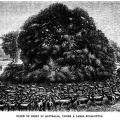82/233
Home / Albums / Natural History / Mammals /
Red Blood-Corpuscles presenting, some the Surfaces, others the Edges, of their Discs, together with Single Representatives of Four Types of Leucocyte.
A, the most common type, highly amœboid and phagocytic. Its protoplasm is finely granular, its nucleus multipartite.
B, a leucocyte closely similar to the last, but larger, and containing an undivided nucleus. It is shown with a cluster of particles of soot in its body-substance.
C, a young leucocyte, or “lymphocyte.”
D, a coarsely granular leucocyte. Its granules stain brightly with acid dyes—e.g., eosin or acid fuchsin.
- Author
- The Body at Work
by Alexander Hill
Published 1908
Available from gutenberg.org - Posted on
- Tuesday 1 September 2020
- Dimensions
- 900*848
- Tags
- human
- Albums
- Visits
- 752
- Downloads
- 33
 Download Photo
Download Photo





